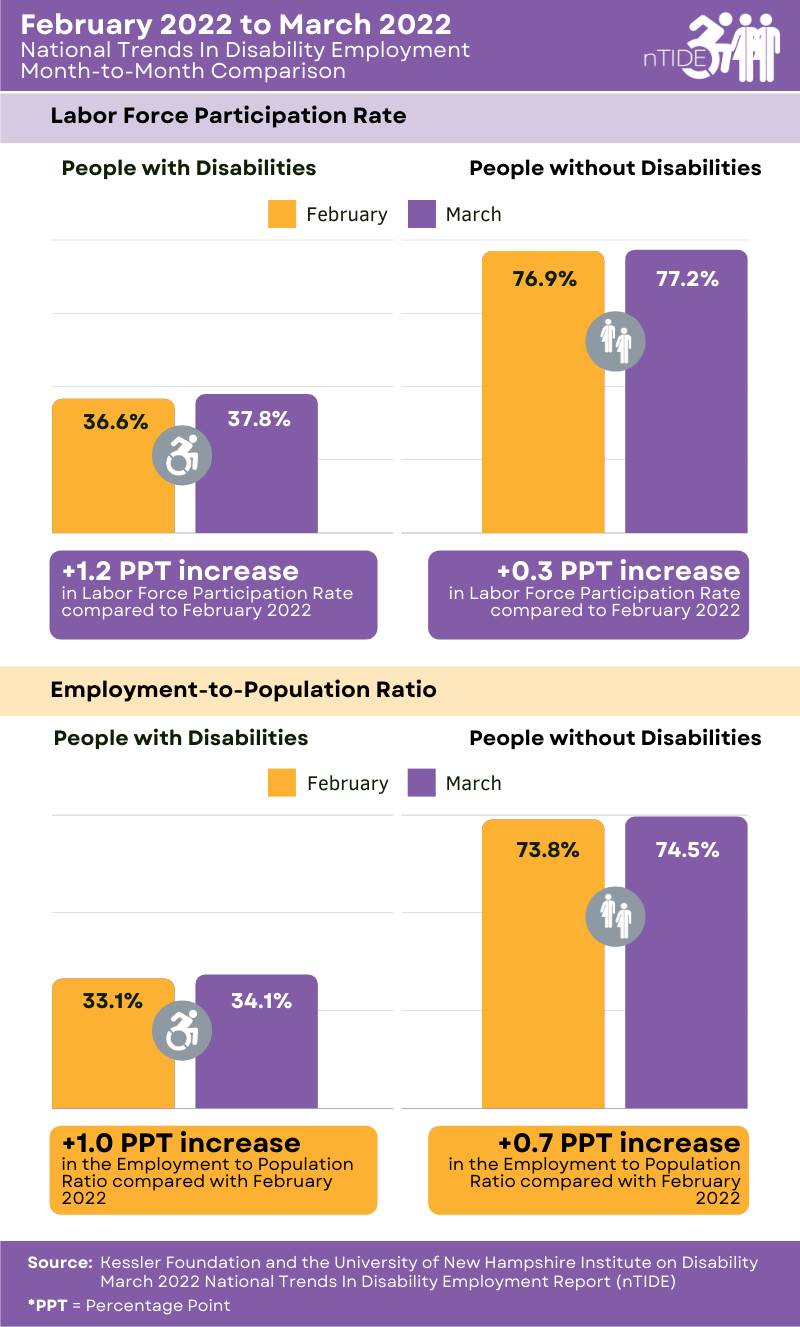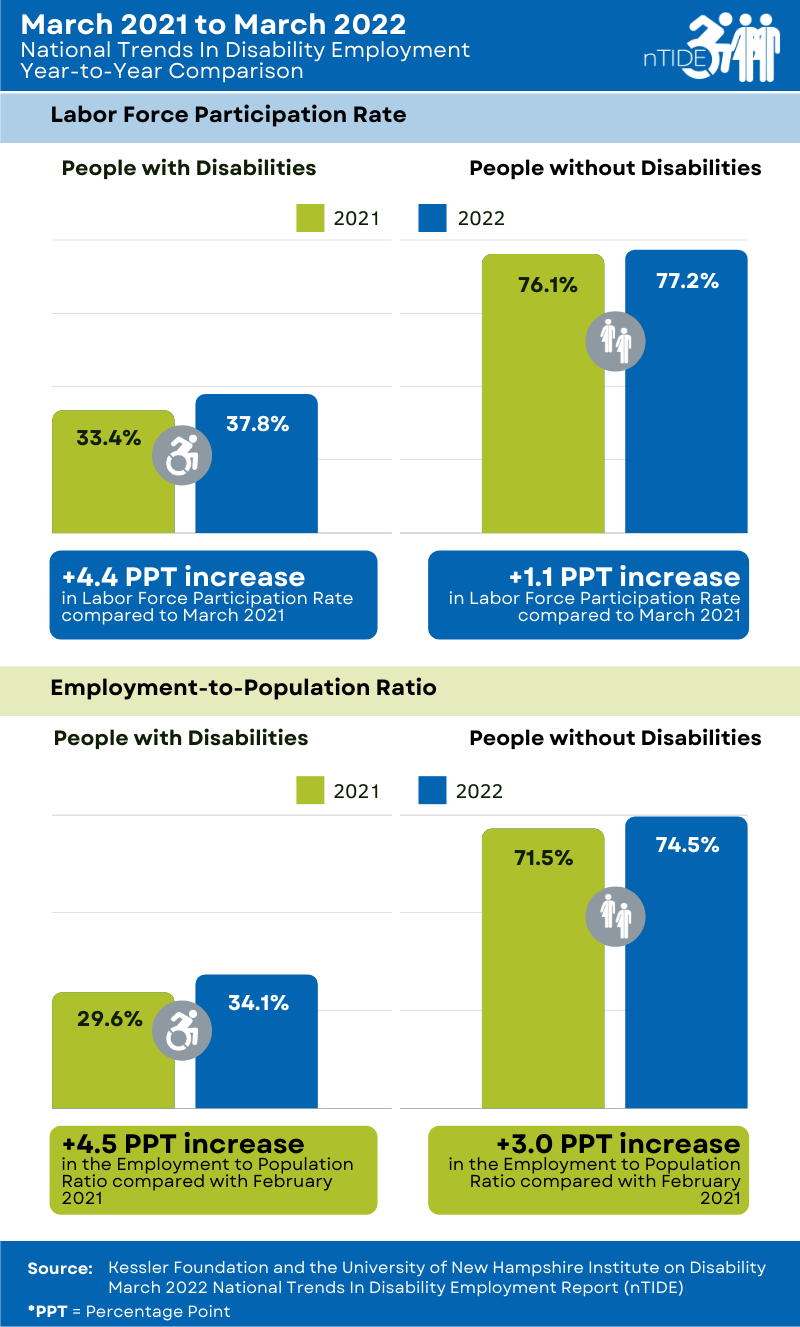National Trends in Disability Employment (nTIDE) – issued semi-monthly by Kessler Foundation and the University of New Hampshire
East Hanover, NJ – April 1, 2022 – Job numbers increased in March for people with disabilities, continuing a six-month trend above historic highs, according to today’s National Trends in Disability Employment – Monthly Update (nTIDE), issued by Kessler Foundation and the University of New Hampshire’s Institute on Disability (UNH-IOD). Numbers also were up for people without disabilities, who are still striving to reach their pre-pandemic levels of employment.

people with disabilities and without people without disabilities.
Month-to-Month nTIDE Numbers (February to March 2022 comparison)
In the US Bureau of Labor Statistics (BLS) Jobs Report released Friday, the employment-to-population ratio for working-age people with disabilities increased from 33.1 percent in February to 34.1 percent in March 2022 (up 3.0 percent or 1.0 percentage points). For working-age people without disabilities, the employment-to-population ratio increased slightly from 73.8 percent in February to 74.5 percent in March 2022 (up 0.9 percent or 0.7 percentage points). The employment-to-population ratio, a key indicator, reflects the percentage of people who are working relative to the total population (the number of people working divided by the number of people in the total population multiplied by 100).
“It’s significant that the major economic indicators have remained above historic highs for people with disabilities over the last six months,” said John O’Neill, PhD, director of the Center for Employment and Disability Research at Kessler Foundation. “This trend contrasts sharply with what we saw after the Great Recession when people with disabilities lagged people without disabilities for several years.”
Findings were similar for March’s labor force participation rates. For working-age people with disabilities, the labor force participation rate increased from 36.6 percent in February to 37.8 percent in March 2022 (up 3.3 percent or 1.2 percentage points). For working-age people without disabilities, the labor force participation rate also increased from 76.9 percent in February to 77.2 percent in March 2022 (up 0.4 percent or 0.3 percentage points). The labor force participation rate is the percentage of the population that is working, not working and on temporary layoff, or not working and actively looking for work.
“Rather than participating in the Great Resignation, people with disabilities remained engaged in the labor market throughout the pandemic. Their labor force participation rate did not drop appreciably early-on in the pandemic,” remarked Andrew Houtenville, PhD, professor of economics and the research director of the University of New Hampshire’s Institute on Disability, adding, “and has hovered just above its historic high, which dates back to just before the Great Recession started to hit the labor market.”

with and without disabilities.
Year-to-Year nTIDE Numbers (March 2021 to March 2022)
The employment-to-population ratio for working-age people with disabilities increased from 29.6 percent in March 2021 to 34.1 percent in March 2022 (up 15.2 percent or 4.5 percentage points). For working-age people without disabilities, the employment-to-population ratio also increased from 71.5 percent in March 2021 to 74.5 percent in March 2022 (up 4.2 percent or 3 percentage points).
The labor force participation rate for working-age people with disabilities increased from 33.4 percent in March 2021 to 37.8 percent in March 2022 (up 13.2 percent or 4.4 percentage points). For working-age people without disabilities, the labor force participation rate also increased from 76.1 percent in March 2021 to 77.2 percent in March 2022 (up 1.4 percent or 1.1 percentage points).
In March 2022, among workers ages 16-64, the 5,693,000 workers with disabilities represented 3.9 percent of the total 147,691,000 workers in the U.S.
Ask Questions about Disability and Employment
Each nTIDE release is followed by a nTIDE Lunch & Learn online webinar. This live broadcast, hosted via Zoom Webinar, offers attendees Q&A on the latest nTIDE findings, provides news and updates from the field, as well as invited panelists to discuss current disability-related findings and events. On April 1, at 12:00 pm Eastern, Lydia X.Z. Brown, JD, from the Georgetown University Disability Studies Program and Autistic Women & Nonbinary Network, joins Drs. Houtenville and O’Neill, and Denise Rozell, Policy Strategist at AUCD. Join live or visit the archives at: ResearchonDisability.org/nTIDE.
nTIDE COVID Update
Join us on April 22, at 12:00 pm Eastern for the mid-month COVID update - an in-depth comparison of the latest unemployment numbers for people with and without disabilities. Register at: COVID-19 Updates - 2022 | Center for Research on Disability.
NOTE: The statistics in the nTIDE are based on Bureau of Labor Statistics numbers but are not identical. They are customized by UNH to combine the statistics for men and women of working age (16 to 64). nTIDE is funded, in part, by grants from the National Institute on Disability, Independent Living and Rehabilitation Research (NIDILRR) (90RT5037) and Kessler Foundation.
About Kessler Foundation
Kessler Foundation, a major nonprofit organization in the field of disability, is a global leader in rehabilitation research that seeks to improve cognition, mobility, and long-term outcomes -- including employment -- for people with neurological disabilities caused by diseases and injuries of the brain and spinal cord. Kessler Foundation leads the nation in funding innovative programs that expand opportunities for employment for people with disabilities.
About the Institute on Disability at the University of New Hampshire
The Institute on Disability (IOD) at the University of New Hampshire (UNH) was established in 1987 to provide a coherent university-based focus for the improvement of knowledge, policies, and practices related to the lives of persons with disabilities and their families. For information on the NIDILRR-funded Employment Policy and Measurement Rehabilitation Research and Training Center, visit ResearchOnDisability.org.